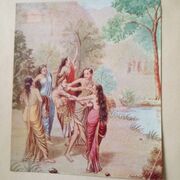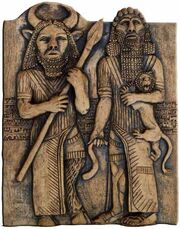The unicorn known from medieval bestiaries, also called the rhinoceros in Greek, was first described in the allegorical animal book popularly called the Physiologus. It is a small animal similar to a kid (young goat) with one horn in the middle of its forehead. Despite its small size, it is very fierce and hunters cannot take it by force. However, they found a way to slay it and this is what they do: they take a young virgin girl and leave her alone on its path. When the unicorn sees her, it abandons all ferocity, approaches her, puts its head on her lap and falls asleep. Then the hunters come out of their hiding, kill the creature and take it to the palace of the king.
Isidore of Seville was of opinion that the unicorn and the rhinoceros was the same creature and so later writers, such as Saint Gregory or Albertus Magnus, add Pliny's description of the latter, saying the unicorn is of boxwood color (very pale, bordering with white[1]), kills elephants by striking them in the belly with its horn and one was exhibited in Pompey the Great's games in Rome.
Those who trusted Pliny more than the bestiaries, preferred to describe the unicorn exactly like his rhinoceros: it is a huge animal, as big as an elephant but lesser in height, on account of shorter legs. It bears one horn on its snout.
Name[]
The name "unicorn" (in the form unicornis or unicornus) is a direct Latin translation of Greek μονόκερως and means "one-horned". It is taken from the Septuagint, which used the name for an animal living in India and described by Pliny to translate the Hebrew re'em. Vulgata uses "unicornis" in several places and "rhinoceros" in others; those two words were often considered synonyms.
Bartholomeus Anglicus recognizes several kinds of unicorns: rhinoceros, monoceros and egloceron (sometimes spelled eglisseron). The last one is garbled Αιγόκερως, which is Capricornus in Latin. He describes it as being identical to the Bestiary unicorn; similar to a kid and with a single sharp horn on the forehead.
The Arabs know a creature called "harish" (حريش) or "harshan" (حريشن), which is identical in most respects to the European unicorn. This appears to be a cognate with Hebrew "keresh" (קרש) and may have come from the shortening of Greek ῥινόκερως or μονόκερως. The Arabic translation of the Physiologus uses dayyā (ديّا), which is probably a corruption of rimā (ريما), which in turn comes from the re'em.
Attraction to virginity[]
Milk[]
The unicorn's affinity to human virgins has many differing explanations behind it. Early versions of the Physiologus, quoted by Arabs, say that the unicorn is naturally fond of milk and the girl is supposed to give it her breasts to suck, but the obvious fact that only the breasts of a feeding mother produce milk and that is somewhat incompatible with virginity, prevents us from accepting that hypothesis. There are 3 ways around the problem. First, capturing the unicorn is impossible and the story is only to underline the impossibility of the task (compare with a folk song "The Unquiet Grave": "Go fetch me water from the desert | And blood from out of stone | Go fetch me milk from the fair maid's breast | That young man never had known").
Another solution is that the creature expects to suck milk, but never realizes that intention. Al-Tawhidi says that the unicorn jumps into the virgin's arms and although there is no milk in her breasts, it begins to suckle them with such a gusto, that it is overpowered with intoxication as if it were drunk with wine. It is then easily taken.
The third solution is that the girl does not need to be chaste. The Arab writers seem to mention virginity only out of respect to the original work and as an insignificant detail, and don't consider it a rule. Ibn Bakhtishu supplants the virgin with a girl from a brothel that tempts the creature with her breasts. The animal sucks them for about an hour and then falls asleep from milk.
"Odour of chastity"[]
In European Middle Ages, the unicorn's attraction to the virgin was often associated with the creature's keen sense of smell and some kind of scent peculiar to virgins. John of San Geminiano says the unicorn, while stepping along through the forest, "smells the odour of a virgin". Philippe de Thaon says that the virgin needs to uncover her breast and by following its smell the unicorn finds her. He then kisses her breast and falls asleep. Richard de Fournival likens himself to the unicorn, being seduced by the virgin's smell: "And so I say that I was captured by smell, and my lady has continued to hold me since by smell, and I have abandoned my own will in pursuit of hers."
It seems that the smell does not need to be natural, as John Tzetzes believes the unicorn can even be caught by a young man, as long as he is dressed up in woman's clothes, heavily perfumed and seated outside the beast's lair. When the wind blows, the unicorn is drawn out. The man opens his arms and embraces the animal, which is stunned by the wondrous scent.
Origin[]

Ekasringa joins the playing girls
It is believed that Physiologus, rather than inventing its stories, merely adopted known legends for the needs of Christian moralism. A likely source is the Indian story of Ekashringa (एकशृङ्ग, "one-horned"), who was a boy born from a doe. He lived in the forest as a hermit without ever knowing the existence of women. At the same time, the king of the neighboring country suffered from the lack of a male heir. He heard about the monk and desired him to be his son-in-law. He sent his daughter Nalini to seduce him. The princess filled her carriage with large amounts of food, drink and sweets and went to the hermitage with her ladies-in-waiting. There she set up and started playing and singing. When Ekashringa went out, the girls invited him to play and eat. Having never known anything but his hermitage, he took them for fellow monks, although strange, with long hair and weird bumps on their chests. Nevertheless, he felt an inexplicable attraction to them. When they invited him to their "monastery", he couldn't say no. He married the princess and after the old king's death, ascended to the throne.

Enkidu and Gilgamesh
The tale can be further traced to the ancient Epic of Gilgamesh. Gilgamesh was a ruler of the city of Uruk, whose strength was unparalleled among any men and who oppressed his subjects, presumably by forcing them to participate in blood sports. The gods decided to find a different venue of venting his energy. They created a wild man called Enkidu (portrayed with hooved legs and horns on his head) and let him go outside of the city. A hunter started finding his snares destroyed and one time saw a man covered in hair free animals from the traps. He consulted the king who sent a prostitute called Shamhat with a mission to seduce Enkidu. Shamhat clothed him, fed him and spent a week with him on lovemaking. After that time, Enkidu found that animals no longer recognize him and flee at his sight. Shamhat convinced him to come with her to the city. Enkidu became a rival and later a friend of Gilgamesh.